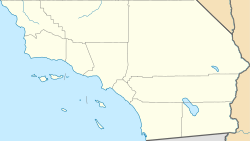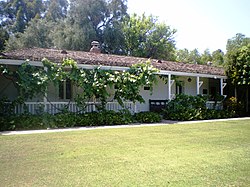Inglewood, California | |
|---|---|
| Nickname: "City of Champions" | |
 Location of Inglewood in Los Angeles County, California | |
Location within the Los Angeles Metropolitan Area | |
| Coordinates: 33°57′27″N118°20′46″W / 33.95750°N 118.34611°W | |
| Country | United States |
| State | California |
| County | Los Angeles |
| Established | 1888 |
| Incorporated | February 7, 1908 [1] |
| Government | |
| • Type | Council–Manager–Commission |
| • Mayor | James T. Butts Jr. |
| • City Council | Eloy Morales Jr. George Dotson Alex Padilla Dionne Faulk |
| • City Manager | Louis A. Atwell [2] |
| • City Clerk | Aisha Thompson |
| Area | |
• Total | 9.09 sq mi (23.55 km2) |
| • Land | 9.07 sq mi (23.48 km2) |
| • Water | 0.023 sq mi (0.06 km2) 0.27% |
| Elevation | 130 ft (40 m) |
| Population | |
• Total | 107,762 |
| • Rank | 12th in Los Angeles County 74th in California |
| • Density | 11,890/sq mi (4,590/km2) |
| Time zone | UTC−8 (Pacific) |
| • Summer (DST) | UTC−7 (PDT) |
| ZIP Codes [6] | 90301–90312 |
| Area codes | 310,424, 213/323 |
| FIPS code | 06-36546 |
| GNIS feature IDs | 1660799, 2410106 |
| Website | cityofinglewood.org |
Inglewood is a city in southwestern Los Angeles County, California, United States, in the Greater Los Angeles metropolitan area. As of the 2020 U.S. census, the city had a population of 107,762. It is in the South Bay region of Los Angeles County, near Los Angeles International Airport. [7] The Inglewood area was developed following the opening of the Venice–Inglewood railway in 1887 and incorporated as a city on February 14, 1908. [8] The Inglewood Oil Field is the largest urban oil field in the US.
Contents
- History
- Spanish era
- Mexican era
- American era
- Religious history
- Trash-hauling pact
- Geography
- Neighborhoods
- Climate
- Demographics
- 2020 census
- 2010 census
- Mapping L.A.
- Homelessness
- Arts and culture
- Landmarks
- Public libraries
- Symphony
- Open Studios
- Sports
- Professional sports
- Olympic and Paralympic Games
- 2026 FIFA World Cup
- Government
- Municipal
- Federal representation
- State representation
- Los Angeles County
- Regional
- Politics
- Education
- Public and private schools
- Schools history
- Media
- Newspapers
- Filming locations
- Infrastructure
- Transportation
- Fire
- Health
- Notable people
- Born in Inglewood
- Other residents
- Sister cities
- See also
- References
- Further reading
- External links
The city is a major hub for professional sports with several teams that have played in Inglewood's venues. The Kia Forum, an indoor arena, opened in 1967 and hosted the Los Angeles Lakers of the National Basketball Association, Los Angeles Kings of the National Hockey League, and the Los Angeles Sparks of the Women's National Basketball Association, until the opening of Crypto.com Arena in 1999. Two National Football League teams—the Los Angeles Rams and Los Angeles Chargers—have played at SoFi Stadium since it opened in 2020; the stadium will also host the opening and closing ceremonies of the 2028 Summer Olympics. The Los Angeles Clippers of the National Basketball Association began play at Intuit Dome in 2024.
























